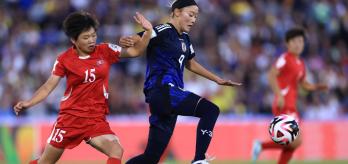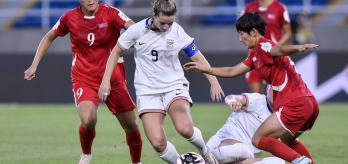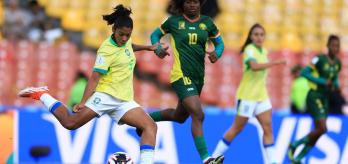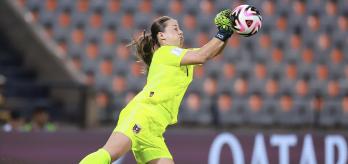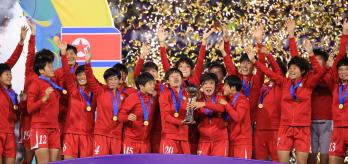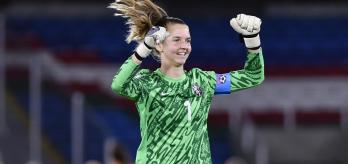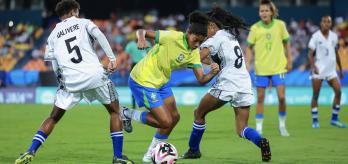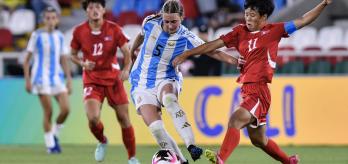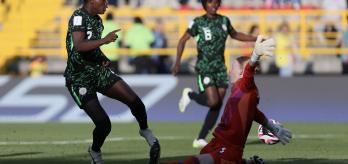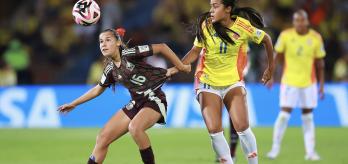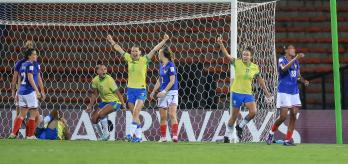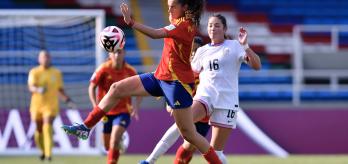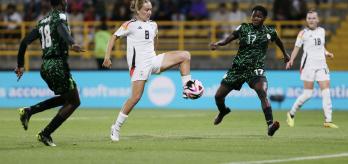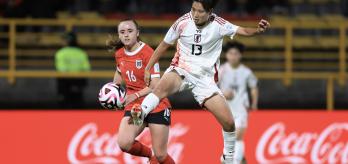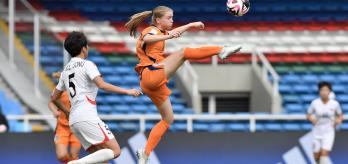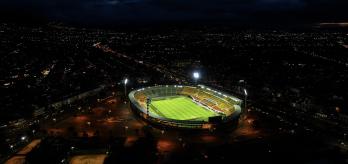Group D was a competitive and physical group with all four teams bringing different styles of play. All three teams progressed to the knockout stages, while Venezuela demonstrated their continued development at this level, scoring two goals in their defeat to Germany and securing a 0-0 draw with Korea Republic.
Germany
In possession
A striking feature of Germany’s attacking game is the rotation and synergy that exists between their midfield trio of Alara Şehitler (17), Sofie Zdebel (8) and Sophie Nachtigall (10). Their full-backs get involved in the attacking play and they are very aggressive at getting numbers into the penalty area when the ball is in the final third. Their wide players deliver strong crosses while they also have players who are comfortable at taking defenders on 1v1, showing the variety the side’s variety in attack.
Out of possession
Often using a 1-4-1-4-1 shape without the ball, Germany’s midfield is just as important when they are out of possession. Şehitler (17) is their most effective defensive midfielder and proves to be a strong ball-winner and reader of the game when her team is defending. Germany work hard as a unit and demonstrate strong awareness of roles of responsibilities but have looked a little vulnerable when opponents are counter-attacking at speed or when dealing with long balls that are flicked on.
Nigeria
In possession
Using a direct, attacking style, Nigeria preferred to play from their defensive line straight to their forward players. Centre-back Lucky Nkpa (4) is technically strong on the ball when playing the longer forward passes towards her centre-forward. In addition, they have players that are strong and technical when running with the ball at speed, making it difficult to stop them once they generate momentum in their attacking play. They are also strong in 1v1 attacking duels and can turn defenders who come in to mark tightly.
Out of possession
Often using a 1-4-4-1-1 shape, defensive midfielder, Philomina Yina (10), plays a key role in breaking up opposition attacks if they try to play to their attacking midfielders in her vicinity. Nigeria’s block was mostly low but when they won the ball back, they could counter-attack at speed and capitalise on the space left open by the opposition.
Korea Republic
In possession
Traditionally, Korea Republic are a technical team that can build through the thirds efficiently but this team demonstrated that they have versatility in their attack with a willingness to play more direct at times. Centre-forward Jeong Da-bin (19) is a strong target player who can hold the ball up and bring other players into the game higher up the pitch. Her technical ability sometimes led to her being fouled in dangerous areas and they used some well-crafted and clever set plays in these circumstances, with Kim Shinji (6) being instrumental in the deliveries.
Out of possession
Using a 1-5-4-1 mid or low block, their players were committed to maintaining a compact defensive structure. Their aggression when pressing meant they were very effective at forcing the ball wide and backwards. In 1v1 situations, the wide defenders were effective at stopping crosses and players covered for each other when defenders ahead of them were engaged in pressing.
Venezuela
In possession
Venezuela had a very positive approach to their attacking play, looking to maintain possession and play through the centre of the pitch using combinations. Marianyela Jiménez (10) was particularly influential when running with the ball to break lines or passing forward to release players ahead of her.
Out of possession
This team worked very hard for each other, pressing as high up the pitch as they could while maintaining a compact team shape. Venezuela were particularly good at winning second balls and used this effectively as a platform to build attacks with Sabrina Araujo (4) leading in this area. If they did not win the first ball from their own, long goal kicks, they were effective at winning the second balls and building from there.






